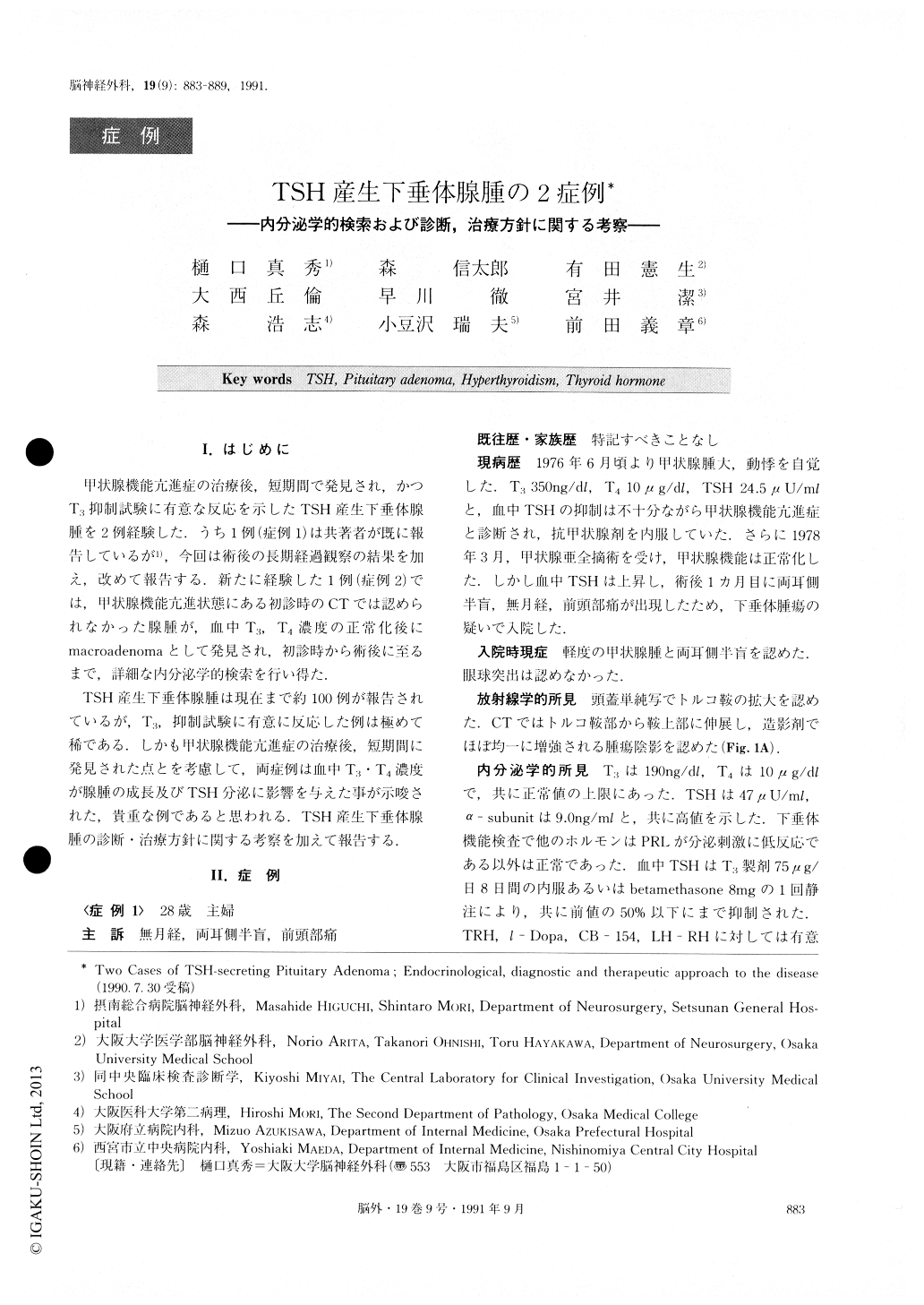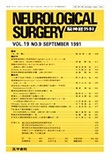Japanese
English
- 有料閲覧
- Abstract 文献概要
- 1ページ目 Look Inside
I.はじめに
甲状腺機能亢進症の治療後,煙期間で発見され,かつT3抑制試験に有意な反応を示したTSH産生下垂体腺腫を2例経験した.うち1例(症例1)は共著者が既に報告しているが1),今回は術後の長期経過観察の結果を加え,改めて報告する.新たに経験した1例(症例2)では,甲状腺機能亢進状態にある初診時のCTでは認められなかった腺腫が,血中T3,T4濃度の正常化後にmacroadenomaとして発見され,初診時から術後に至るまで,詳細な内分泌学的検索を行い得た.
TSH産生下垂体腺腫は現在まで約100例が報告されているが,T3,抑制試験に有意に反応した例は極めて稀である.しかも甲状腺機能亢進症の治療後,短期間に発見された点とを考慮して,両症例は血中T3・T4濃度が腺腫の成長及びTSH分泌に影響を与えた事が示唆された,貴重な例であると思われる.TSH産生下垂体腺腫の診断・治療方針に関する考察を加えて報告する.
Abstract
Two cases of TSH-secreting pituitary adenoma were reported. Endocrinological and immunohistochemical features of these cases were described and problems in diagnosis and treatment of the rare disease are dis-cussed.
<case 1> A 28 year-old woman suffered from hyper-thyroidism with a relatively high value of serum TSH (T3 ; 350ng/dl, T4 ; 10.0 μg/dl/, TSH ; 24.5 μU/ml) . She was treated with antithyroid drug and then under-went subtotal thyroidectomy.
Although the levels of serum T3 and T4 were lowered to within normal range, the level of serum TSH still remained high. One month later, she developed frontal headache, amenorrhea and bitemporal hemianopsia. A CT scan showed an en-hanced mass in the sellar and suprasellar region. Preop-erative endocrinological studies showed elevated values of TSH (47 μU/ml) and its α -subunit (9.0ng/ml). The levels of both T3 (19Ong/dl) and T4 (10.0 μg/dl) were near the upper normal limit. Serum TSH was suppres-sed by administration of exogenous T3, but did not re-spond to exogenous TRH, l-Dopa nor bromocriptine. Under the diagnosis of TSH-secreting pituitary adeno-ma, the patient was operated on by craniotomy and re-ceived local radiation therapy (50Gy). In 1990, 12 years after the treatment, she is well and endocrinologically normal. Immunohistochemical study revealed that most tumor cells were positive for TSH.
<case 2> A 28 year-old woman visited our hospital for examination of hyperthyroidism. Serum level of TSH was detectable (4.5 μU/ml) . A CT scan per-formed at that time disclosed no pituitary tumor. Thy-roid function was normalized by antithyroid drug, but the level of TSH was still high and progressively in-creased. One year later, a CT scan revealed an intrasel-lar tumor which was enhanced by contrast medium. Preoperative endocrinological studies showed a high value of both serum TSH (117.9 μU/ml) and its α-subunit (14.0ng/ml). Serum T3 (105ng/dl) and T4 (6.7 p g/dl) were within normal ranges. Serum TSH was increased by exogenous TRH. Both T3 and somatosta-tin suppressed the elevated level of TSH, while gluco-corticoid, l-Dopa and bromocriptine did not affect serum TSH. Under the diagnosis of TSH-secreting pituitary adenoma, transsphenoidal selective ade-nomectomy was performed. On the day following the surgery, the values of serum TSH, T3 and T4 were re-markably lowered (TSH ; 1.9 μU/m/, T3; 42ng/dl, T4 ; 3.9 μg/ dl) Immunohistochemical study demon-strated that most tumor cells were positive for β-subunit of TSH.
These two presented cases of TSH-secreting pituit-ary adenomas are unique in that The secretion of TSH by these adenomas was suppressed by administration of exogenous T3 and that relatively rapid growth of the adenomas might be induced by normalization of serum T3 and T4.
In order to disclose a microaclenoma, repeated ex-aminations of the sellar region by CT and/or MRI are essential in patients with hyperthyroidism combined with detectable levels of serum TSH, particularly in the follow-up period after treatment for hyperthyroidism.

Copyright © 1991, Igaku-Shoin Ltd. All rights reserved.


